China has unveiled the design of a new reusable shuttle to take cargo to and from the country's space station.
The Haolong space shuttle is being developed by the Chengdu Aircraft Design and Research Institute under the state-owned Aviation Industry Corporation of China (AVIC). It is one of two winning projects stemming from a call for proposals from China's human spaceflight agency, CMSA, to develop low-cost cargo spacecraft.
China currently uses its robotic Tianzhou spacecraft to send cargo to the Tiangong space station. But, taking a leaf out of NASA's book to encourage commercial resupply options for the International Space Station, CMSA wanted new, low-cost ideas that can also return experiments and other cargo to Earth, unlike the Tianzhou, which burns up on reentry.
Haolong will launch atop of a rocket and land horizontally on Earth on a runway. The space shuttle measures 32.8 feet (10 meters) long and 26.2 feet (8 m) wide, and weighs less than half of the Tianzhou capsule, which has a mass of up to 31,000 pounds (14,000 kilograms). The winged spacecraft is now in the engineering flight verification phase, meaning its design and systems are under review before being built.
(Update: the video seems not to work for me, but I found the right video on youtube showing how a flight would work.)


Laws of physics at work. Similar aerospace engineering challenges will have similar solutions, regardless of who does the R&D.